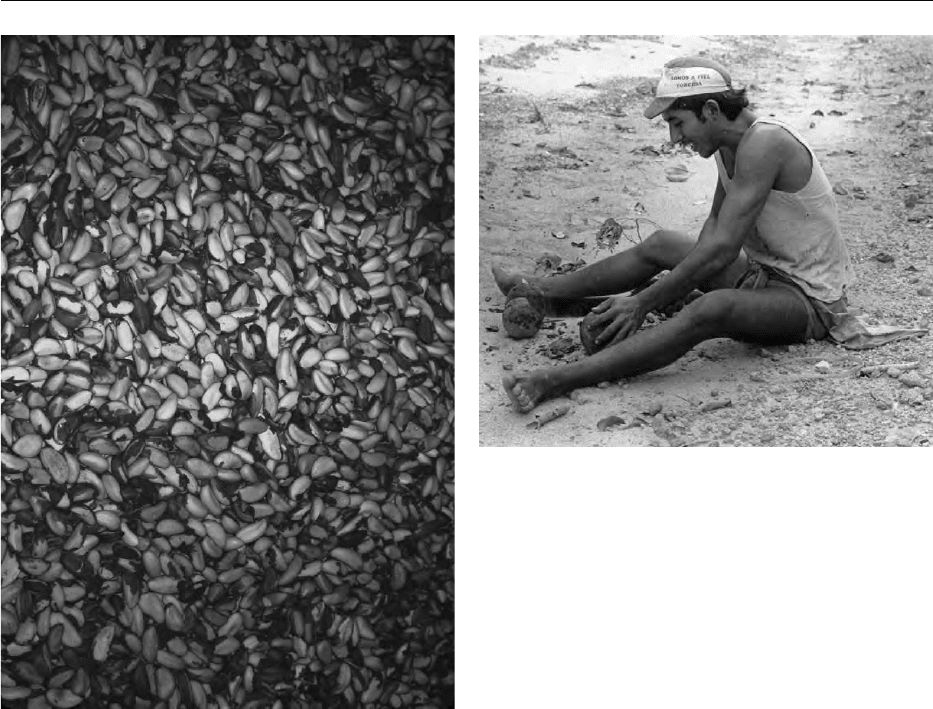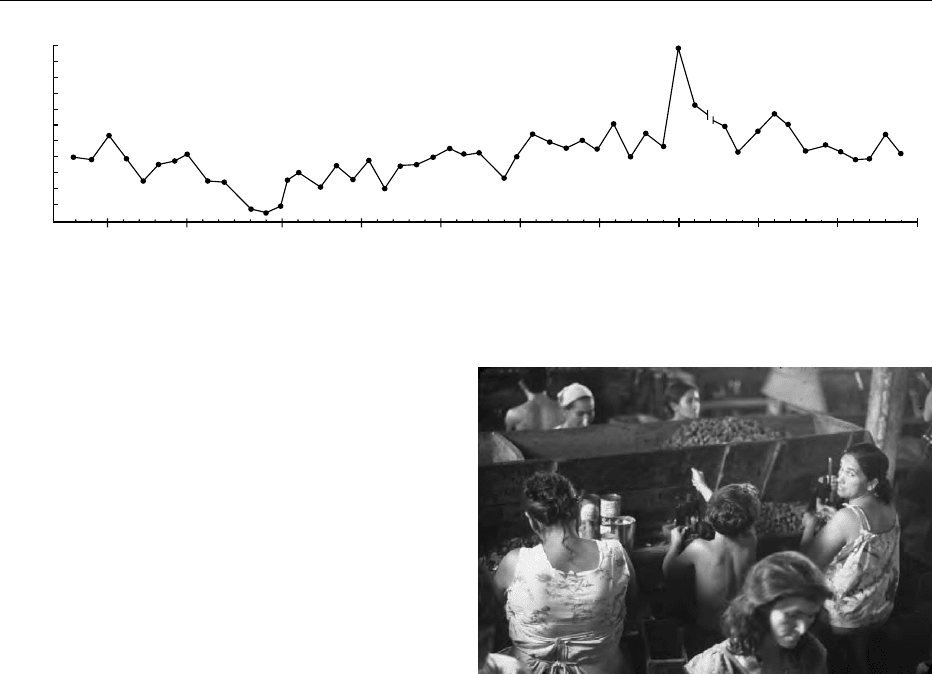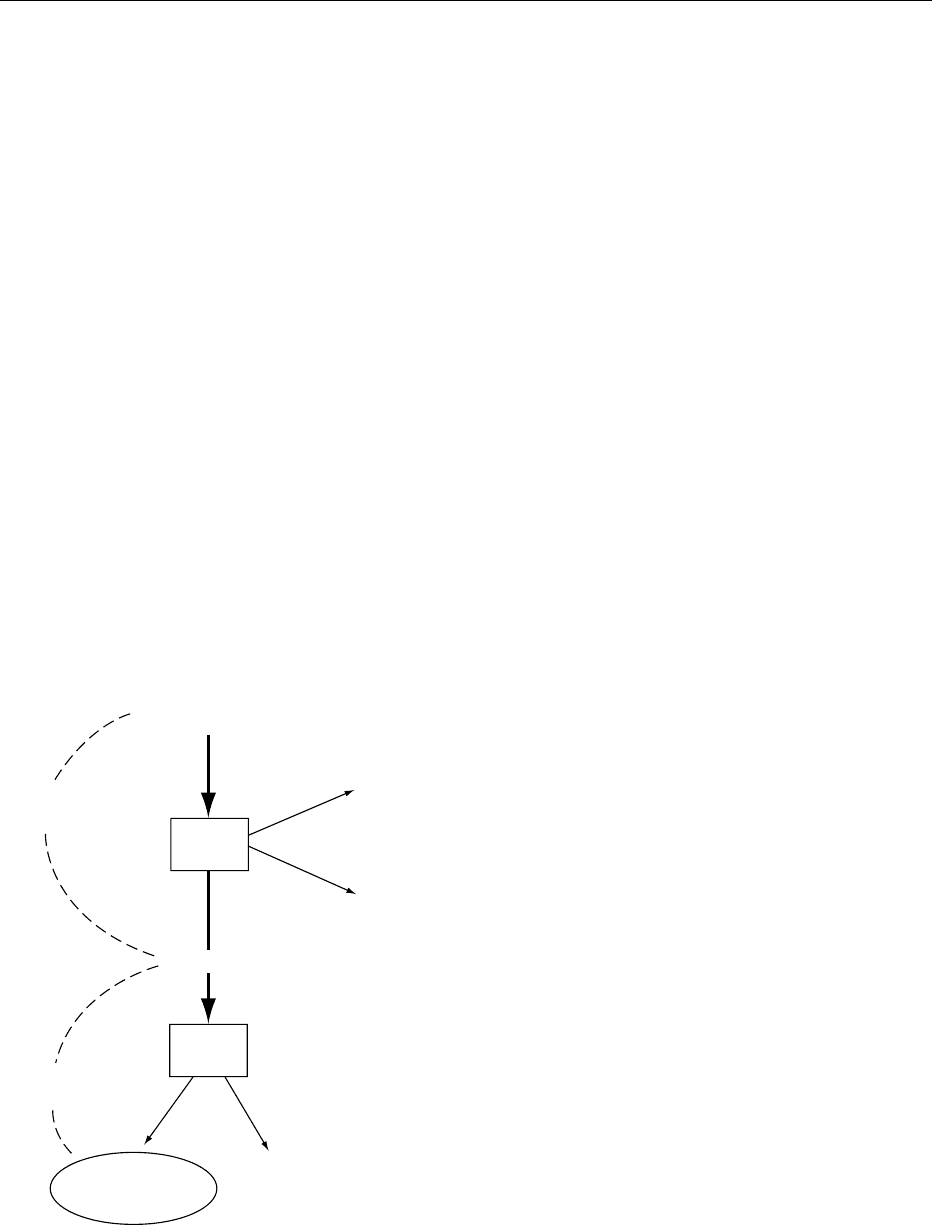Caballero B. (ed.) Encyclopaedia of Food Science, Food Technology and Nutrition. Ten-Volume Set
Подождите немного. Документ загружается.


plants. Though an orange cauliflower is now being
marketed, the application of this research may result
ultimately in the introduction of higher-carotenoid
varieties of some of the world’s staple crops and a
reduced incidence of vitamin A deficiency (which
can be reduced by ingestion of b-carotene-rich foods).
0078 The brassica vegetables, though not unique in this
respect, are also good sources of various flavonoids
and their conjugates to which significant antioxidant
activity has been ascribed. For example, the preven-
tion of lipid peroxidation for which these compounds
appear to be reasonably well suited may be an
important mechanism for reducing the severity of
age-related degenerative diseases such as arthritis,
cardiovascular disease, and cancer.
See also: Antioxidants: Natural Antioxidants; Synthetic
Antioxidants; Synthetic Antioxidants, Characterization
and Analysis; Role of Antioxidant Nutrients in Defense
Systems; Cancer: Diet in Cancer Prevention; Functional
Foods; Glucosinolates; Goitrogens and Antithyroid
Compounds; Salad Crops: Dietary Importance; Leaf-
types; Vegetables of Temperate Climates: Cabbage and
Related Vegetables; Oriental Brassicas; Vegetarian
Diets; Vitamin K: Properties and Determination;
Physiology
Further Reading
Facciola S (1990) Cornucopia: A Source Book of Edible
Plants. Vista, CA: Kampong.
Fahey JW and Stephenson KK (1999) Cancer chemoprotec-
tive effects of cruciferous vegetables. HortScience 34(7):
1159–1163.
Fahey JW, Zhang Y and Talalay P (1997) Broccoli sprouts:
an exceptionally rich source of inducers of enzymes that
protect against chemical carcinogens. Proceedings of the
National Academy of Sciences of the United States of
America 94: 10367–10372.
Go
´
mez-Campo C (ed.) (1999) Biology of Brassica Coeno-
species. Amsterdam: Elsevier.
Gray AR (1982) Taxonomy and evolution of broccoli.
Economic Botany 36: 397–410.
Kays SJ and Dias JCS (1996) Cultivated Vegetables of the
World. Athens, GA: Exon Press.
Lucier G (1999) Broccoli: Super food for all seasons.
Agricultural Outlook April: 8–12. Washington, DC:
Economic Research Service, USDA.
Rupp R (1987) Blue Corn and Square Tomatoes.
Pownal, UT Storey Communications/Garden Way
Publishing.
Seelig RA (1971) Fruit & Vegetable Facts and Pointers.
Alexandria, UA: United Fresh Fruit and Vegetable Asso-
ciation.
Switzer S (1727) The Practical Kitchen Gardiner. London:
Thomas Woodward.
Toussaint-Samat M (1987) A History of Food (trans.,
1992). Cambridge, MA: Blackwell.
Tsunoda S, Hinata K and Gomez-Campo C (1980) Brassica
Crops and Wild Allies: Biology and Breeding. Tokyo:
Japan Scientific Societies Press.
Vaughan JG, MacLeod AJ and Jones BMG (eds.) (1976)
The Biology and Chemistry of the Cruciferae. London:
Academic Press.
Zhang Y, Talalay P, Cho C-G and Posner GH (1992) A
major inducer of articarcinogenic protective enzymes
from broccoli: Isolation and elucidation of structure.
Proceedings of the National Academy of Sciences of
the United States of America 89: 2399–2403.
BRAZIL NUTS
G T Prance, University of Reading, Reading, UK
Copyright 2003, Elsevier Science Ltd. All Rights Reserved.
Background
0001 Brazil nuts are produced in the crown of one of the
tallest trees of the Amazonian rainforest. An import-
ant dietary item of the indigenous Indian and local
populations, the Brazil nut later entered into com-
merce and is a major export of the Amazonian coun-
tries, Bolivia, Brazil, and Peru. The nuts (Figure 1) are
harvested almost exclusively from wild trees in the
forest, rather than from plantations. They are high
in protein and oils and are also a useful source of
thiamin (vitamin B
1
). (See Thiamin: Properties and
Determination.)
Description and Taxonomy
0002The Brazil nut comes from the species Bertholletia
excelsa Humb. & Bonpl., the only species in this
genus of the Brazil nut family, Lecythidaceae. Several
other species of the family have edible seeds, the best
known being the sapucaia nut or monkey pot
(Lecythis pisonis Cambess.). However, the sapucaia
fruits open at maturity on the trees, and the seeds are
removed by bats, rendering large-scale harvesting
almost impossible. The Brazil nuts are produced in
large, woody, round fruits that are slightly larger than
BRAZIL NUTS 615

a baseball. These fruits, or pyxidia as they are termed,
drop to the ground intact when they are mature,
14 months after flowering has taken place. Between
10 and 25 seeds, or nuts, as they are incorrectly called
according to the botanical definition of a nut, are
arranged rather like the segments of an orange inside
the pyxidium. This explains their characteristic flat-
tened triangular shape. In nature, a large terrestrial
rodent, the agouti (Dasyprocta), or squirrels open the
pyxidium and bury the nuts in caches some distance
from the parent tree; this is the means of seed disper-
sal for this species. Brazil nut gatherers go to the trees
in January to March, when the fruits are falling and
before the rodents have removed all the nuts. The
fruits are generally gathered in the morning, because
there is less danger of injury from fruit fall. The fruits
weigh 0.5–2.5 kg and fall from a height of 40–50 m,
and injury and deaths have been reported of collect-
ors struck by falling fruits. The gatherers open the
pyxidia skillfully with machetes (see Figure 2)and
pour out the nuts into their baskets. They trade their
harvest for goods, and the nuts are shipped to factor-
ies for processing. Before exportation, they are pas-
teurized with steam to kill toxic fungi, and in many
cases, they are also shelled and canned.
Distribution and Ecology
0003Brazil nuts grow in nonflooded rainforests of the
Guianas and Amazonian Colombia, Venezuela, Peru,
Bolivia, and Brazil. They tend to grow in natural
clusters or stands of 50–100 trees. These stands are
known as manchales in Peru and castanhais in Brazil.
Usually, there are one or less trees per hectare, but
stands of 15–20 trees per hectare have been reported
in Madre de Dios, Peru. Some of the clustering may
be the result of planting by Indians who formerly
occupied the area. Brazil nuts grow in forests with
an annual rainfall of 1400–2800 mm and do better
where there is at least a short, dry season. The trees
are light-demanding, i.e., they need gaps in the forest
before they can grow to adult size.
Flowering and Pollination
0004Flowering occurs in the dry season, which begins in
September and can extend until February. The peak
of flowering is September and October throughout
most of central and eastern Amazonia, and slightly
earlier to the west. After flowering and pollination,
the fruits take approximately 14 months to mature
and fall off in January and February.
fig0002Figure 2 Brazil nut gatherer opening nuts. Reproduced from
Brazil Nuts, Encyclopaedia of Food Science, Food Technology and
Nutrition, Macrae R, Robinson RK and Sadler MJ (eds.), 1993,
Academic Press.
fig0001 Figure 1 Brazil nuts. Reproduced from Brazil Nuts, Encyclo-
paedia of Food Science, Food Technology and Nutrition, Macrae R,
Robinson RK and Sadler MJ (eds.), 1993, Academic Press.
616 BRAZIL NUTS

0005 The flowers have a complicated androecium struc-
ture, which forms a closed hood over the top of the
flower. Nectar is produced inside the hood. Large
bees are the only insects that have the strength to
force open the flower to reach the nectar. As the
bees force open the springed hood, their backs are
forced against the pollen-bearing stamens and the
stigmatic surface where pollen is deposited. The bees
therefore carry the pollen from flower to flower. Bees
that have been found visiting Brazil nut flowers are
from the genera Bombus, Centris, Epicharis, and
Eulaema. The Brazil nut is largely self-incompatible,
i.e., the tree requires pollen from another tree in order
for seed set to take place. Low seed set has been found
in trees that are isolated in forest clearings and in
areas of disturbance. The maintenance of the pollin-
ation system is essential for the production of Brazil
nuts. Therefore, plantations that are surrounded by
forest where the pollinators thrive are much more
likely to be productive than plantations that cover
larger open areas away from the forest.
Chemistry
0006 The Brazil nut is rich in oil and protein (see Table 1).
The oil extracted from the seed is bright yellow,
almost odorless, and with a pleasant nutty taste. It
has a specific gravity of 0.9165 at 15
C, solidifies at
4
C and does not become rancid easily. The first
extraction of oil from the seeds yields an excellent
cooking oil, and the second extraction produces an oil
suitable for making soap and burning in lamps.
Hence, it furnished many of the needs of the Indian
population of Amazonia. The residue left after
pressing the seeds can be used as an animal feed.
The average protein content of defatted Brazil nut
flour is about 46% and contains all the essential
amino acids, making both the nut and the flour highly
nutritious. The principal amino acid content of the
nuts is given in Table 2, which shows them to be rich
in leucine. The nuts also contain vitamin A, vitamin
B
1
(thiamin), vitamin B
2
(riboflavin), and niacin,
being a particularly good source of thiamin and
niacin.
0007Brazil nuts contain selenium, a powerful anti-
oxidant. The amount in a Brazil nut (16–30 mgg
1
)
exceeds the US recommended daily dose. Some
people consume a Brazil nut a day to achieve the
recommended dose. Brazil nuts can cause hair loss if
consumed in large quantities owing to their selenium
content. Brazil nuts accumulate selenium because of
the similarity of this element to sulfur. There is often a
sulfur deficiency in Amazonian soil, especially after
long-term harvesting of the nuts. If the soil is selen-
ium-rich, this is used by the plant as a substitute for
sulfur. When sulfur fertilization is used, the selenium
content of the nuts is reduced. Brazil nuts are rich in
the sulfur amino acids methionine and cysteine. (See
Amino Acids: Properties and Occurrence; Niacin:
Properties and Determination; Retinol: Properties
and Determination; Riboflavin: Properties and Deter-
mination; Thiamin: Physiology.)
tbl0001 Table 1 Chemical properties of Brazil nuts (as a percentage of the total weight)
Seeds from Peru
a
Seeds from Brazil
a
SeedsfromBrazil
b
Seeds fromBrazil
c
Oil 65.0 67.0 70.0 67.45
Protein 17.0 17.0 13.9 15.48
Ash 3.0 4.0 3.89
Crude fiber 0.9 3.21
Water 4.0 5.0 2.0 5.49
Carbohydrates 10.1 7.0 3.83
Ash/fiber/carbohydrates 14.1
100.0 100.0 100.0 99.80
a
From Sa
´
nchez JS (1973) Explotacio
´
n y comercializacio
´
n de la Castan
˜
a en Madre de Dios. In: Informe No. 30. Lima: Ministerio de Agricultura, Direccio
´
n
General de Forestall y Caza.
b
From SUDAM (Superintende
ˆ
ncia do Desenvolvimento da Amazonia) (1976) Estudos e pesquisas sobre a castanha-do-Par˜. Bele
´
m, Brazil: Ministerio do
Interior, Departamento de Recursos, Naturais.
c
From Knuth (1939) Lecythidaceae. In: Engler A (ed.) Pflanzenreich IV, vol. 219a, pp. 1–146.
tbl0002Table 2 Principal amino acids found in the Brazil nut
a
Amino acid content
(mgper kilogram fresh weight)
Lysine 4313
Threonine 3263
Valine 4888
Methionine 4088
Leucine 9250
Isoleucine 3450
Phenylalanine 4385
Tryptophan 1400
a
From SUDAM (Superintende
ˆ
ncia do Desenvolvimento da Amazonia)
(1976) Estudos e pesquisas sobre a castanha-do-Par˜. Bele
´
m, Brazil:
Ministerio do Interior, Departamento de Recursos, Naturais.
BRAZIL NUTS 617

Economic Botany
0008 Until recently, Brazil nut seeds were second only
to rubber as an export crop from Amazonian Brazil.
The production from 1933 to 1986 has ranged from
a low of 3557 tonnes in 1944 to 104 487 tonnes
in 1970 (Figure 3). The production in 1986 was
36 136 tonnes. The low of 1944 was caused by
World War II. In the Department of Madre de Dios
in Peru, 20% of the forests are rich in Brazil nuts, and
it is estimated that two-thirds of the population are
engaged in Brazil nut extraction and processing. The
annual production of nuts from the state of Pando in
Bolivia is estimated to be between 10 and 12 000
tonnes. Most of the seeds are exported to France,
the UK, the USA, and Germany. Very little on the
crop is consumed domestically in either Brazil or
Peru. Recent price fluctuations of Brazil nuts on the
commodity market have made it harder for the pro-
ducers. The nuts are exported intact or with the seed
coat removed. In the latter case, the seeds are soaked
for 8–10 h in a tank of water, after which they are
submerged in boiling water for 1–2 min. The seeds are
dried to make the embryo shrink away from the seed
coat; this facilitates the removal of the seed without
breakage. Broken seeds have a lower export value and
are often used locally for oil extraction and in the
soap industry. The dried seeds are placed in a manual
press, and pressure is applied at both ends to crack
open the seed coat (see Figure 4). The seeds are
canned for export. Brazil nuts can be eaten raw or
roasted, and are used in confectionery.
0009 Brazil nut oil is often used in soaps, shampoo, and
hair and skin conditioning products. It is a good
moisturizer for the skin and provides antioxidant
benefits. Brazil nuts require careful handling and
steam sterilization, because they are highly suscep-
tible to bruising and molding, which can cause
the accumulation of aflatoxins. Sometimes, whole
batches of nuts exported in their shells have to be
rejected because of the danger of aflatoxins. This is
rare in properly prepared and packaged nuts.
0010In addition to producing the nut, Brazil nut trees
yield excellent timber. Although it is against the law
to fell Brazil nut trees in Brazil, there is still a clandes-
tine market for its timber. The timber is also used in
Peru. The fibrous bark of the tree is used for caulking
boats, and in folk medicine, a bark tea is used as a
cure for liver ailments. The empty fruit cases are used
for fuel and for making a vast array of tourist
souvenirs. The world-wide Brazil nut market in 1999
was estimated to be $35 million.
See also: Amino Acids: Properties and Occurrence;
Niacin: Properties and Determination; Retinol:
Properties and Determination; Riboflavin: Properties and
Determination; Thiamin: Properties and Determination;
Physiology
Further Reading
Chang JC et al. (1995) Selenium content of Brazil nuts from
two geographic locations in Brazil. Chemosphere.
110
100
90
80
70
60
50
40
30
20
10
1935 1940 1945 1950 1955 1960 1965 1970 19801975 1985
⫻ 10
3
t
fig0003 Figure 3 Brazil nut seed production from 1933 to 1984 (data from the Anu
A
˜
rio Estat
U
´
stica do Brasil). Reproduced from Brazil Nuts,
Encyclopaedia of Food Science, Food Technology and Nutrition, Macrae R, Robinson RK and Sadler MJ (eds.), 1993, Academic Press.
fig0004Figure 4 Cracking Brazil nuts in a processing factory, O
´
bidos,
Brazil. Reproduced from Brazil Nuts, Encyclopaedia of Food Sci-
ence, Food Technology and Nutrition, Macrae R, Robinson RK and
Sadler MJ (eds), 1993, Academic Press.
618 BRAZIL NUTS

Knuth R (1939) Lecythidaceae. In: Engler A (ed.) Pflanzen-
reich IV 219a: 1–146.
Mori SA and Prance GT (1990a) Taxonomy, ecology, and
economic botany of the Brazil nut (Bertholletia excelsa
Humb & Bonpl.: Lecythidaceae). Advances in Economic
Botany 8: 130–150.
Mori SA and Prance GT (1990b) Lecythidaceae – Part II.
Flora Neotropica Monograph 21: 1–375.
Moritz A (1984) Estudos biolo
´
gicos da castanha-do-Brasil
(Bertholletia excelsa H.B.K.). EMBRAPA, Centro de
Pesquisa Agropecua
´
rio do Tro
´
pico Umido Documentos
29: 1–82.
Mu
¨
ller CH (1981) Castanha-do-Brasil; estudos agrono
´
mi-
cos. EMBRAPA, Centro de Pesquisa Agropecua
´
rio do
Tro
´
pico Umido. Miscela
ˆ
nea 2: 1–25.
Nelson BW, Absy ML, Barbosa EM and Prance GT (1985)
Observations on flower visitors to Bertholletia excelsa
H.B.K. and Couratari tenuicarpa A.C.Sm. (Lecythida-
ceae). Acta Amazo
ˆ
nica 15(supplement 2): 225–234.
Sa
´
nchez JS (1973) Explotacio
´
n y comercializacio
´
ndela
castan
˜
a en Madre de Dios. In: Informe No. 30. Lima:
Ministerio de Agricultura, Direccio
´
n General de
Forestall y Caza.
Souza AH (1963) Castanha-do-Para
´
; estudo bota
´
nico, quı
´
-
mico e tecnolo
´
gico. Edic¸o
˜
es S.I.A. Estudos Te
´
cnicos 23:
1–69.
SUDAM (Superintende
ˆ
ncia do Desenvolvimento da Ama-
zonia) (1976) Estudos e pesquisas sobre a castanha-do-
Para
´
. Bele
´
m, Brazil: Ministerio do Interior, Departa-
mento de Recursos, Naturais.
Sun SS et al. (1987) Properties, biosynthesis and processing
of a sulfur-rich protein in Brazil nut (Bertholletia excelsa
H.B.K.). European Journal of Biochemistry 162: 477–
483.
Vaz Pereira IC and Lima Costa SL (1981) Bibliographia de
Castanha-do-Para
´
(Bertholletia excelsa H.B.K.). Bele
´
m,
Brazil: EMBRAPA, Centro de Pesquisa Agropecua
´
rio do
Tro
´
pico Umido.
BREAD
Contents
Dough Mixing and Testing Operations
Breadmaking Processes
Chemistry of Baking
Sourdough Bread
Dietary Importance
Dough Fermentation
Dough Mixing and Testing
Operations
S D Deshpande, Central Institute of Agricultural
Engineering, Bhopal, India
Copyright 2003, Elsevier Science Ltd. All Rights Reserved.
Dough Mixing
0001 One of the most important operations in a bakery is
the accurate and thorough mixing of ingredients.
Mixing reduces nonuniformities of gredients in com-
position, properties, or temperature of bulk materials
or products in and out of a reactor, and was defined
by Quillen as the ‘intermingling of two or more dis-
similar portions of a material, resulting in the attain-
ment of a desired level of uniformity, either physical
or chemical, in the final product.’ The term ‘mixing’
includes more than just the mechanical actions that
blend ingredients to a homogeneous mass. There may
also be an incorporation of air and the formation of
minute bubbles in a fat/water phase, a development of
hydrated flour proteins into an elastic mass known as
gluten, and an increase of temperature by a build up
of mechanical heat. There is no fundamental basis for
classifying the gluten proteins on the basis of aqueous
alcohol extractability, although such a classification
does have technological significance. Gliadin and glu-
tenin are known to impart entirely different physical
properties to the gluten network in a wheat-flour
dough. Gliadin behaves mainly as a viscous liquid,
when hydrated, and confers extensibility, allowing
the dough to rise during fermentation, whereas glute-
nin provides elasticity and strength, preventing the
dough from being overextended and collapsing either
during fermentation or in baking. This article dis-
cusses the purpose of kneading of dough, types of
mixers for dough, dough mixing and dough develop-
ment, and empirical methods in physical dough
testing.
BREAD/Dough Mixing and Testing Operations 619

Purpose of Dough Mixing
0002 The dough is kneaded before it is allowed to ferment,
and again before it is molded into the desired shapes.
The purpose of kneading is to remove some of the
excess carbon dioxide in order to prevent over-
stretching of the gluten strands, and to distribute the
yeast cells throughout the dough. Kneading also tends
to keep the dough at a uniform temperature. The
dough is kneaded sufficiently when it has a smooth,
‘satiny’ surface, and small bubbles appear under the
surface.
Mixing of Dough – Dimensional Analysis
0003 Dough mixing is the most common unit operation in
the food industry, finding widespread application in
the bakery, snack food, and breakfast cereal indus-
tries. Dimensional analysis of this operation reveals
how potential scale-up problems can be diagnosed
before any experimentation is initiated.
0004 Consider the schematic representation of a dough
mixer that is shown in Figure 1. Cereal chemists
generally consider the specific energy input as being
indicative of the degree of ‘development’ of the
dough. Specific energy is defined as the total energy
dissipation per kilogram of dough. Assuming that the
dough is Newtonian, one can perform a dimensional
analysis for the power consumed by a dough mixer.
The key variables used are given in Table 1.
0005 By inspection, the dimensionless relationship that
is sought is
P
rN
3
D
4
L
¼ f
ND
2
r
m
;
d
D
;
F
D
3
;
h
D
;
t
D
: ð1Þ
0006Solving for power and making use of the general
rule that in laminar flow, the power is proportional to
the velocity squared, it can be shown that
PamN
2
D
2
Lg
d
D
;
F
D
3
;
h
D
;
t
D
: ð2Þ
0007The specific energy is simply the power dissipation
multiplied by the mixing time divided by the mass of
dough in the mixer. Then, the required time of mixing
is given by
t ¼
o
P
ð3Þ
where o ¼specific energy input. If the scaled-up
mixer is geometrically similar to the pilot mixer, this
simplifies to
ta
1
N
2
: ð4Þ
0008A conclusion can be drawn from eqn (4). If
the plant mixer operates at the same speed as the
pilot plant mixer, the times required for developing
the dough are identical. This provides the designer
with a clear-cut direction as to how to design the
scaled-up mixer. Unfortunately, for most actual appli-
cations, geometric similarity is not maintained when
scaling up bakery mixers.
0009How does one handle a real dough with
non-Newtonian properties? Complete analysis is im-
possible since the dough exhibits very complicated,
time-dependent behavior. However, one can draw
some useful inferences from the non-Newtonian ana-
lyses that follow.
0010If the dough were a simple power law fluid, the
viscosity in the list of variables would be replaced by
the flow consistency and the flow index. The result of
the dimensional analysis would be
P
rN
3
D
4
L
¼ f
N
2n
D
2
r
m
; ...; n
: ð5Þ
Rolling bar
Spider
Driven shaft
Stationary bar
fig0001 Figure 1 Schematic representation of a dough mixer. From
Valentas KJ, Leuine L and Clark JP (1991). Dimensional analysis
– mixing and sheeting of doughs. In: Food Processing Operations
and Scale-up, pp. 359–361. New York: Marcel Dekker, with permis-
sion.
tbl0001Table 1 Key variables used in the text
Variable Description Units
P Power ML / T
3
r Density M / L
3
m Viscosity M / LT
N Rotational speed 1 / T
F Volumetric charge L
3
d Roller diameter L
b Breaker bar diameter L
D Mixer diameter L
h Clearance between rollers and wall L
t Clearance between breaker and rollers L
L Length of mixer L
620 BREAD/Dough Mixing and Testing Operations

0011 The time required to mix the dough is then
ta
1
N
1þn
: ð6Þ
0012 As before, if geometric similarity is maintained,
the time required to mix the dough is held con-
stant on scale-up if the speed of the mixer is held
constant.
0013 For a viscoelastic dough, which can be approxi-
mated as a Maxwell body, the variable list would
have the relaxation time added. The new dimension-
less group that appears to incorporate this new term is
the Weissenberg (Deborah) number. The result is
P
rN
3
D
4
L
¼ h
ND
2
r
m
; y
R
N
; ð7Þ
where y
R
is the relaxation time of the dough. The
conclusions are unchanged. No matter how compli-
cated a model, even a model containing an infinite
number of relaxation times, the conclusion is the
same.
Types of Mixers for Dough
0014 Mixers and kneaders are necessary for the proper
blending or mixing of the various ingredients. Liquids
can be easily blended using propeller-type agitators in
a tank. For blending of premixes or preparation of
adjuncts, ribbon blenders, twin-cone, and V-shell
blenders are usually employed when dry ingredients
are to be mixed.
0015 Dough mixing can be carried out using horizontal,
vertical, reciprocating, or continuous mixers as re-
quired. The horizontal type may have a fixed or tilting
bowl, while the vertical mixer may be a planetary or
fixed spindle type. The continuous mixers may be of
the agitator-in-tube type, or the rotor and stator head
type.
Horizontal Dough Mixers
0016 These mixers can be used to mix various mixtures
ranging in consistency from thin batters to tough
doughs. They must be used when gluten development
is desirable, e.g., in breadmaking. These mixers have
a horizontal U-shaped bowl mounted on a rigid frame
with a drive motor. Their capacities range from 10 kg
upwards. Bowls are usually made of stainless steel or
stainless steel-clad mild steel. Bowls are sometimes
provided with jackets for the circulation of cold or
hot water.
0017 High-speed mixers for gluten development usually
contain a single axle on which two or more arms
parallel to the front of the mixer are mounted. The
limited clearance between the jacket wall and the
agitator bars causes the dough to be repeatedly
stretched and kneaded, resulting in quick gluten
development. These mixers can usually be operated
in two speed ranges, namely 30–60 and 40–80 r.p.m.
In the slow-speed mixers, agitators of various forms,
e.g., eight-arm, Z, etc., are employed on one or two
axles.
0018The agitator configuration and its speed affect the
action. Slow-speed Z or eight-arm mixers have a
speed range of 14–60 r.p.m. (25 r.p.m. on an average).
0019The high-speed horizontal mixers are also called
kneaders, and may contain bars projecting from the
axle at right angles, while the bowl has radical bars
intermeshing with axle bars. This construction gives
very efficient dough kneading, and is particularly
suitable for tough doughs.
0020The dough is discharged from these mixers by
tilting the bowl so that the top is brought to a for-
ward-facing position. In some models, the front of the
bowl consists of a tightly fitting door, which can be
raised and lowered independently of the immobile
section of the bowl, and the dough is discharged
through this door. The bowl-tilting mechanism may
be hand-operated or it may be operated by a separate
motor.
Vertical Mixers
0021Vertical mixers consist of a movable bowl or trough
with one or two vertical shafts that may be stationary
or may have planetary movement. The agitators
themselves may be of various sizes and configurations.
The most important design in the vertical mixer is the
planetary mixer, which is particularly suitable for
mixing batters or adjuncts such as icings. The agitator
is called ‘planetary’ as it, apart from revolving around
its own vertical axis at a relatively high speed, also
moves in circles as it rotates around the bowl. This
motion ensures ‘beater’ action throughout the bowl
contents. The agitator may be provided with a vari-
able-speed mechanism, and the bowl can be raised
and lowered by a separate drive. The agitator may be
of any of the various types available, e.g., simple,
curved single-arm, wire meshing, or paddle gate.
0022The hook-type agitator gives a good kneading
action to the dough, resulting in development of the
gluten with a minimum of tearing. The wire-mesh
type agitator gives a good ‘beater’ action with
maximum air incorporation. The paddle-type agita-
tor ensures good mixing coupled with scraping of the
bowl sides. Bowls are usually provided with covers to
prevent splashing or dusting. Capacities range from
10 kg upwards.
0023Spindle-type mixers are used mainly for biscuit
doughs. Their special advantage is with saltine
doughs, in which case they are adapted for mixing
BREAD/Dough Mixing and Testing Operations 621

in special mobile troughs used for fermentation.
Thus, sponges and doughs need not be transferred in
and out of the mixer between the various stages. The
spindle speed is usually low, and spindles can be
raised to allow the trough to be rolled into place
under them. The mixer blades are so designed as to
give a cutting action rather than a kneading or
stretching action to the mix, thus a toughening effect
on the cracker or biscuit doughs is avoided. (See
Biscuits, Cookies, and Crackers: Methods of Manu-
facture.)
0024 In reciprocating agitator or revolving bowl
mixers, a pair of agitator arms travels through
intersecting elliptical paths in a shallow, slowly re-
volving bowl. These mixers are useful for mixing
temperature-sensitive doughs, and also where nuts
and raisins in the mix are to be kept unbroken.
Their output is usually low compared with horizontal
mixers, and they are particularly suitable for pie
doughs and puff pastry.
Dough Mixing and Dough Development
Dough Properties and Mixing Behavior
0025 It is generally agreed that the uniqueness of wheat is
due to its breadmaking quality. Among plant crops,
only wheat flour and, to a limited extent, rye flour
have the ability to form a dough that retains gases and
produces a baked product, particularly leavened
bread, with the desired eating qualities. Wheat-flour
doughs exhibit a wide range of properties when dif-
ferent flour samples are compared. Dough properties
influence both the efficiency of throughput in the
manufacturing plant and the quality of the final
baked product. In discussing the state of dough prior
to baking, we need to differentiate between the con-
tributions from the individual flour and those from the
various treatments, which include added ingredients,
mixing, and intermediate punching, and molding
steps. Dough is a complex material from a rheological
point of view. Knowledge about its structure comes
from fundamental rheological studies, from standard
physical dough testing, including mixing, and from
microscopy.
0026 Because of the trend towards greater use of baking
processes involving intensive mixing and short
fermentation times, much more attention has been
given to basic studies of dough mixing in recent
years. These studies have highlighted the sensitivity
of dough structure to the conditions to which the
dough has been subjected during its development. It
is clear that meaningful interpretations of rheological
measurements can be made only if the state of dough
development is well understood.
Factors Affecting Dough Development
0027The first step in converting flour into bread is the
mixing of flour, water, and other additives. Specific
additives have been incorporated as improvers to
wheat flour. The effects of addition of sodium algin-
ate at 0.1–0.5% levels to wheat flour have been stud-
ied, and it has been observed that sodium alginate can
improve the gas formation/retention power of dough,
thus making it suitable for producing better bread. As
mixing proceeds, the initially incoherent dough mass
develops viscoelastic properties and finally acquires a
sheen, this stage being termed ‘clearing.’ Prolonged
mixing past this point causes the dough to lose its
strength and become plastic and very sticky to the
touch. If the torque on the pins, blades, or arm of
the mixer is monitored against time, the trace rises,
reaches a maximum, and then falls steadily. This is
illustrated in Figure 2 for doughs mixed in a
mixograph. Optimum bread-baking performance
is usually achieved in a region at, or slightly past,
the peak development point.
0028Critical mixing intensity and critical work input
Two parameters are critical for optimum develop-
ment and hence best performance. These are that
A
B
D
C
fig0002Figure 2 Mixogram traces. The sequence from A through D
may be used to represent either doughs of increasing mixing
requirements mixed at a fixed intensity, one dough mixed at
increasing intensities or one dough mixed at a fixed intensity
but containing increasing additions of cysteine.
622 BREAD/Dough Mixing and Testing Operations

(1) the mixing intensity must be above a minimum
critical value, and (2) the total work imparted to the
dough must be above a certain minimum value. Both
parameters vary according to the flour used. Before
discussing these requirements more fully, it is useful
to consider the mechanical and mixing efficiencies of
different dough mixers. The distinction between these
two quantities is illustrated in Figure 3. A percentage
of the total energy consumed by the mixer motor is
available for performing mechanical work on the
dough. This is called the mechanical efficiency. How-
ever, not all of this energy is utilized for mechanical
development of the dough but that portion which is
utilized is denoted the ‘mixing efficiency’ of the mixer.
0029 Mixing requirements of flours vary widely, and
Figure 2 illustrates the mixing behavior of four flour
types. The mixing curves are for doughs that have
been mixed at a constant and moderate speed. Flour
A has high mixing requirements, and the rate of
mixing used is insufficient to develop the dough; such
a dough would be a failure in a baking test. Flour B is
a moderately strong flour that does develop at this
mixing speed, although there is an initial induction
period before the dough begins to exert any appre-
ciable torque on the mixer. Flour C is of medium
strength, and flour D is a comparatively weak flour
that develops quickly. We may also make use of
Figure 2 to illustrate the effect of varying the mixing
intensity (i.e., mixing speed) on the mixing curve of a
given dough. At a low speed, the dough does not
develop (trace A). As the mixing speed is increased,
the dough develops after a lag phase (trace B) and
thereafter develops more easily (traces C and D).
With increasing speed, and providing the amount of
work applied to the dough is above a certain level
(corresponding to a point at, or slightly past, the peak
in the trace), the baked loaf volume increases up to a
critical mixing speed, above which it plateaus.
0030For every dough, there exists a critical mixing
speed (which may vary for each mixer) below which
dough handling properties and baked loaf character-
istics are unsatisfactory. In addition, it is necessary to
have imparted a minimum level of work input to the
dough in order to bring it to an optimal developed
state. If the mixing speed or work input level is below
the critical values, unsatisfactory baking results are
obtained. Baking results are less affected by exceeding
the critical values than when these values are not
reached. However, dough-handling properties deteri-
orate, and doughs become sticky; weaker flours are
more sensitive to overmixing.
0031Activated dough development Because some flours
have very long mixing requirements or have critical
mixing speeds that exceed the capacity of many
dough mixers, methods of overcoming these limita-
tions have been devised. One method involves the
addition of reducing agents, particularly sodium
metabisulfite (SMS) and l-cysteine hydrochloride
(cysteine), to doughs. Cysteine reduces the energy
level required to achieve peak dough development,
and also the critical mixing speed necessary to pro-
duce bread of satisfactory loaf volume. We may again
make use of Figure 2 to illustrate the effect of increas-
ing additions of cysteine in altering the mixing char-
acteristics of a strong dough. As the amount of added
cysteine is increased, the nature of the mixing curve
changes from A through D. Cysteine also slightly
increases the rate of energy input at a given mixing
speed and increases the tolerance to undermixing, i.e.,
enables satisfactory bread to be produced with energy
levels less than those required to achieve peak dough
development. There is an optimum level of cysteine
addition, and too high a level causes deterioration of
loaf characteristics.
Intelligent Mixer for Bread Dough
0032To detect ‘dough development’ through digital signal
processings of the mixer’s torque and control mixing
without an ordinary mathematical model, intelligent
Total
gross energy
Mechanical
efficiency
Mixer
motor
Motor
efficiency
Linkage
gears, etc.
Net energy
Mixer
output
Mixing
efficiency
Mechanical
development
fig0003 Figure 3 Diagram illustrating the distinction between mechan-
ical and mixing efficiencies. From Kilborn RH and Tipples KH
(1972) Factors affecting mechanical dough development. I. Effect
of mixing intensity and work input. Cereal Chemistry 49: 34–47,
with permission.
BREAD/Dough Mixing and Testing Operations 623

mixer (speed variable farinograph, robots for flour–
water addition) was developed.
0033 A smoothed farinogram was obtained at constant
mixing intensity, which has a linear part and a
maximum point. Dough at the maximum point was
judged to be fully developed by experienced mixing
operators and was confirmed by the baking test. An
empirical equation about torque mixing and fuzzy
rules to correct nonlinear effects by three parameters
(water content, temperature, and mixing speed) were
obtained. Applying the equation gave a good statis-
tical relation between ‘torque increasing rate’ and
maximum torque value. This statistical relation led
to regulation of the maximum torque value (a good
indicator of dough properties) through flour (or
water) addition by robots. Addition of flour or water
in the early mixing stage caused no apparent influence
on developed dough and baked products. The wave
form of oscillating components, though there seemed
a lot of background noise, had a good correlation
with the degree of dough development. Combining
wave-form analysis with step-wise change of mixing
intensity, it was easy to find the optimum mixing
intensity at each mixing stage. Applying these results,
the intelligent mixer produced a dough with the
desired maximum torque (a good indicator of dough
properties) in a short time.
Empirical Methods in Physical Dough
Testing
0034 A great variety of commercial testing instruments are
used in routine physical tests on dough, either in
quality control or in research work. The deformation
to which dough is subjected in these instruments is so
complicated that it does not allow the evaluation of
the properties of the material in simple physical
terms. Though the results are evaluated more on an
empirical basis than through theoretical analysis, they
provide valuable information on the baking charac-
teristics of the tested material and are a useful tool.
0035 Over the years, a physical testing system has been
developed on the basis of the ‘three-phase concept of
breadbaking.’ The system has been generally accepted
and is used in many commercial milling and baking
operations. It applies three principles of testing: dough
mixing, dough stretching (load–extension), and vis-
cosity measurements on buffered flour suspensions at
elevated temperatures.
Mixing Tests
0036 The two most common instruments used for testing
wheat flour and wheat-flour dough during the mixing
operation are the Brabender farinograph and
National Recording Dough Mixer (mixograph).
0037The Brabender farinograph is essentially a torque-
measuring dough mixer that measures the plasticity
and mobility of dough upon a relatively gentle mixing
at constant temperature. The resistance of the dough
to Z-shaped mixing blades is transmitted to a dyna-
mometer connected to a mechanical recording system,
which records a curve (farinogram) on a kymograph
chart. Farinograms provide information on optimum
mixing time and dough stability on prolonged mixing
(Figure 4). Doughs are tested at a standard water
content known as the ‘farinograph water absorption’
value. This value has to be determined by ‘titration’ of
flour with water, and is the amount of water needed
for a standard optimum consistency of the dough of
500 Brabender units. ‘Forinograph water absorp-
tion,’ dough development time, and dough stability
are useful parameters for the evaluation of the
strength of a flour. In general, the higher the value
of these parameters, the stronger the flour. To express
the strength of a flour on the basis of farinograph data
as a single score, the ‘valorimetric value’ may be
determined by the dough development time and the
decreasing slope of the curve (degree of softening) –
the higher the value, the stronger the flour.
0038The National Recording Dough Mixer is another
widely used instrument for flour testing. Like the
farinograph method, the mixograph method has
become a standard physical dough test. The resist-
ance offered by the dough to four vertical pins revolv-
ing around three stationary pins in a mixing bowl
creates a force that deviates the mixing bowl from
its original position. The torque is proportional to the
shear strength and elasticity of the dough, and may be
used as an index of the dough strength. Both Braben-
der farinographs and National Recording Dough
Mixers may be modified by replacing the mechanical
recording device by an electronic strain-gauge system.
Electronic strain-gauge recording offers several
advantages: ease of calibration in terms of physical
units, greater accuracy because of the elimination of
friction from the torque measuring system, a wide
range of sensitivity, and a record on rectangular
coordinates.
0039For testing the mixing characteristics of dough
under conditions more closely related to those during
mechanical development, a variant of the farino-
graph, known as the Brabender Do-Corder, was de-
veloped. This has a nearly closed mixing bowl with
heavier mixing blades. The dough can be mixed at
higher rates than in the standard farinograph. A more
recent development is the Brabender resistograph.
The instrument was developed to meet the needs of
modern bread-baking technology in which high-
speed mixers subject the dough to both kneading
and stretching. The characteristics of doughs mixed
624 BREAD/Dough Mixing and Testing Operations
